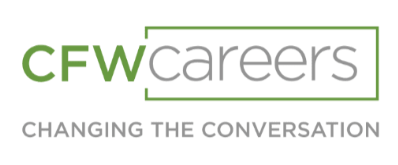Spotlight on Women Leaders: A Conversation with Jenna Nelson, Founder of HerAIgency
Spotlight on Women Leaders Series
👉Celebrating women leaders across industries and advancing the conversation on leadership—reflecting CFW Careers’ expertise in retained executive search, global executive search, and professional coaching.
Welcome to our Women Leaders Spotlight blog series, part of our Changing the Conversation initiative. This series reflects our founding commitment to advancing women in leadership by moving beyond identifying barriers to focusing on solutions—supporting women in their careers while also influencing organizational practices and policymaking.
At CFW Careers, we combine the reach of global executive search with the insight of professional coaching serving leaders and organizations. Since 1973, we’ve been committed to opening doors, creating opportunities, and helping anyone on the rise in their career not just succeed but thrive.
To start, can you introduce yourself and share a bit about your work at HerAIgency, especially in the context of supporting women leaders?
Jenna, founder of HerAIgency
I’m Jenna, founder of HerAIgency. We help female founders and women-led teams bring AI into their businesses in a way that is both approachable and powerful. My work is rooted in making AI practical: building AI Brand Managers that serve as the single source of truth for a company, designing conversational AI that actually sounds human, and setting up systems that save time instead of adding complexity.
My mission is to help women leaders use AI to lighten their mental load, reclaim their time, and scale their impact—without losing their unique voice and vision in the process. My philosophy is simple: align your strategy, automate the right workflows, and appear consistently where your audience is ready to act.
I know firsthand how overwhelming it can feel to sort through endless tools and buzzwords. That’s why HerAIgency focuses on clarity and simplicity. The goal is not more technology for technology’s sake, the goal is to give women leaders practical ways to use AI that make business feel lighter, more consistent, and more scalable.
Many women founders feel overwhelmed by AI and unsure where to begin. What’s a practical first step for experimenting with AI, specifically in people operations, without overcommitting resources?
The easiest first step is to build an AI Brand Manager that acts like your company’s brain. It holds your policies, playbooks, tone of voice, and key information in one place. This way, your HR or People Ops team doesn’t have to answer the same policy questions over and over, and employees know they’re always getting the right answer.
From there, you can create department versions, for example one for Marketing, one for Sales, one for Support. All departments will share the same core foundation but add their own specific processes. This keeps everyone consistent, no matter who is asking the questions. A two-week pilot with a small group is usually enough to prove the value: faster answers, fewer interruptions, and one trusted place to go instead of scattered files.
A two-week starter plan looks like this:
Pick one People Ops problem to fix—for example, repeat PTO questions or a messy onboarding checklist.
Gather the basics: handbook, benefits summary, holiday calendar, expense rules, and who to ask for unusual cases.
Load those into the Brand Manager with clear instructions: how to speak, what it should answer, and when to hand it off to a human.
Invite 5 to 10 teammates to try it. Ask them to use it before Slacking HR. Keep a short form to capture anything it cannot answer.
Check results daily. Update the brain in one place, not scattered files. If a policy changes, fix it in the core.
Measure a few things only: time saved, accuracy, and whether people would miss it if you turned it off.
After the test:
Keep People Ops running on the Brand Manager.
Copy it to create a Marketing, Sales, or Support version. Add their FAQs and playbooks, but keep the core brand items the same.
Assign one owner for each area to keep content fresh. Do a quick monthly check-in.
Why this works:
One source of truth, one brand.
Faster answers, fewer interruptions.
Easy to scale across teams without starting over.
Watch outs:
Don’t start with a blank chatbot, start with the Brand Manager.
Don’t add sensitive data on day one.
Don’t let updates hide in random files, update the core first.
This approach lets you experiment safely, see results quickly, and expand without wasting resources.
As AI becomes more integrated into the workplace, what skills or mindsets do you think will be most important for women leaders and HR professionals to cultivate in order to guide their teams effectively?
The most important skill is not technical: the skill is learning how to frame problems and see where AI can help. Women leaders and HR professionals don’t need to become AI engineers. They do need to be comfortable experimenting, asking “what if” questions, and running short tests to see what works.
Key mindsets to cultivate:
Curiosity: Treat AI like a teammate you’re still getting to know.
Clarity: Define what “good” looks like before you start.
Transparency: Be open with your teams about how AI is used and what it does not do.
People first: Always measure success by whether your team feels more supported and less overwhelmed.
If leaders adopt these mindsets, AI stops feeling like a threat and starts becoming a practical tool. It’s not about replacing people but rather using the tools to free employees to focus on the work that truly matters.
Some fear AI could replace jobs, while others see it as a way to unlock more human creativity and connection. From an HR and leadership perspective, how can organizations strike the right balance between technology and the human side of work?
AI should never replace the human connections that actually make organizations thrive. The balance comes from using AI to take away the repetitive, administrative work, while protecting space for leaders and teams to focus on coaching, creativity, and collaboration.
A simple rule of thumb I share with clients:
AI assists, humans decide. Use AI to draft, research, or streamline, but keep people in charge of choices that impact pay, health, safety, or well-being.
Job redesign, not job loss. As AI takes tasks off the plate, leaders can re-focus roles toward more meaningful work. As Sam Altman put it in the GPT-5 release: “This is going to enable humans to do more than ever before.”
Transparency builds trust. Employees should always know where AI is being used and why. AI should never replace the parts of work that make people feel valued.
This balance creates organizations that are both more efficient and more human-centered. When done well, AI will not erase jobs but will reshape them to give people more purpose, more creativity, and more capacity.
How can people connect with you and learn more about your work?
The best place to start is my website, heraigency.com. If you’d like to explore working together, you can book a consult at heraigency.com/bookconsult. I also host free weekly Digital Marketing & AI Office Hours at heraigency.com/aiofficehours, where I break down the latest in AI for business in a simple, actionable way.
Through our work in retained executive search and leadership development, at CFW Careers, we’ve seen the powerful impact of amplifying women’s voices in business. This series celebrates women leaders across industries, sharing their perspectives and paving the way for the next generation.


